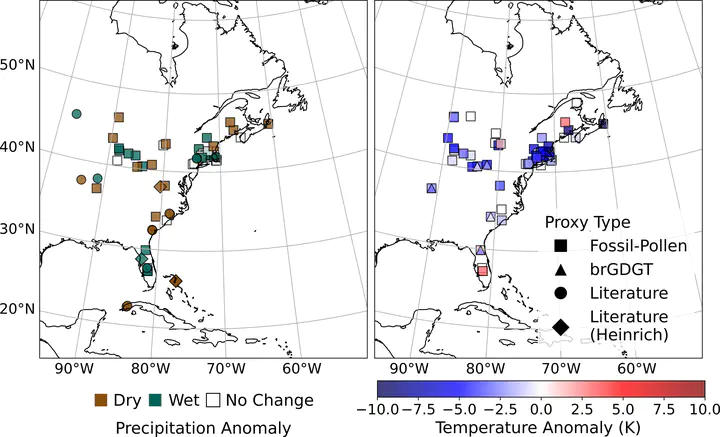Spatial fingerprints and mechanisms of precipitation and temperature changes during the Younger Dryas in eastern North America

Abstract
Here we seek to establish the spatial fingerprints of precipitation and temperature changes in eastern North America during the Younger Dryas and explore the role of meltwater forcing in producing this pattern. Our analyses integrate a network of 42 fossil pollen records and 27 other hydroclimate proxy records, three AOGCM experiments with an imposed freshwater forcing, and the TraCE-21ka transient deglacial simulation. A recent synthesis of proxy-based temperature reconstructions suggests that Younger Dryas temperature reversals were limited to sites north of ~35 degrees N, while southern sites experienced either steady warming or a temperature maximum. Proxy records suggest a tripole precipitation pattern during the Younger Dryas and earlier Heinrich events, with the northeastern United States and Florida wetting, while sites from the Great Lakes Region to the Carolinas were dry. Of the AOGCMs analyzed, TraCE-21ka simulates Younger Dryas mean-field temperature and precipitation changes with the most skill but does not simulate warming in the southeastern United States. The likely role of meltwater forcing in producing subregional warming is indicated by the hosing-experiment AOGCMs, which consistently indicate localized warming and tripole precipitation anomalies, but the reconstructed and simulated patterns are poorly aligned, resulting in moderate model skill of mean-field temperature anomalies and negative skill in simulating past fingerprints. The reconstructed tripole helps reconcile prior apparent discrepancies in proxy records about whether eastern North America was wetter or dryer during the Younger Dryas. Although the hosing-experiment AOGCMs simulate the fingerprints poorly, they show that meltwater forcing can produce subregional warming and wetting in the eastern United States. This is due to enhanced northward heat transport from the Gulf of Mexico induced by a geostrophic adjustment of the midlatitude jet to cooling in the North Atlantic.